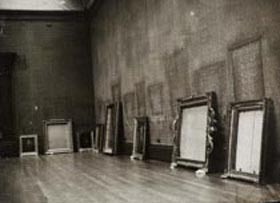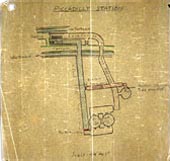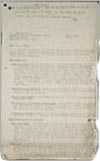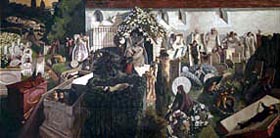|
Evacuation |
Storage |
Rothenstein's role |
Bomb damage |
Other uses of the building |
The re-opening
Evacuation

With its central London location and proximity to the Houses of Parliament, the Tate was a vulnerable target during the Second World War.
Before war broke out in 1939, carefully made plans had been drawn up for the evacuation and safe-keeping of the Collection. Suitable storage locations
for works of art were identified in nearby underground stations and three private country houses - Eastington Hall in Worcestershire, Hellens at Much Marcle
in Hereford and Worcester and Muncaster Castle in Cumberland.
While the owners of these houses were happy to take in the works, their motivations were not always selfless, as seen in the following extract from a letter
from the owner of Muncaster Castle to Assistant Keeper David Fincham: |

Tate works removed for storage
© Copyright holder untraced |
| I welcome the prospect of housing here pictures from the Tate Gallery - in the event of war... their presence here might
help preserve us from, or reduce the number of, the threatened hordes of small children. |

Letter from Sir J Ramsden to David Fincham, 6 January 1939 |
In the early hours of 22 August 1939, Tate Gallery Director Sir John Rothenstein received word of the German-Soviet pact, making war inevitable.
He closed the Gallery the same day, and the evacuation of art works began two days later.
Larger sculptural works were encased in flame retardant crates and remained in the Gallery along with some paintings which were accommodated in a blast
proof storage area in the basement of the building.
Green Park Underground Station and (from 1941) disused tunnels at Piccadilly, were also used for storage by both the Tate and the Museum of London.
The bulk of the Collection however, filling five railway containers, was dispersed to the three country houses accompanied by members of staff to look after
the works. |
 |

Diagram of Piccadilly underground station storage area
© Tate Archive 2003 |

Letter to London Passenger Transport concerning storage of artworks in the Piccadilly store
© Tate Archive 2003 |
Did you know?

Stanley Spencer's painting The Resurrection, Cookham was considered to be too large to move to safety, so a brick wall was built in front of it to
protect it and the painting spent the war incarcerated where it hung... |

Sir Stanley Spencer The Resurrection, Cookham, 1924-7
© Estate of Stanley Spencer. All Rights Reserved, DACS 2002 |
|
